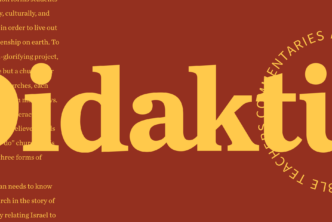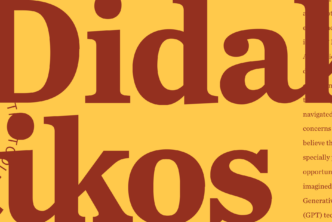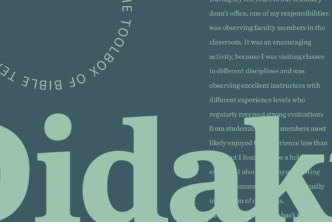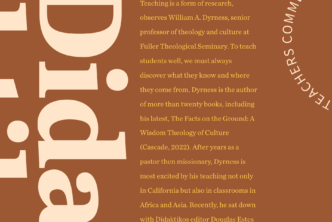By John D. Meade
In biblical and theological instruction and writing, it is common to refer to “the LXX” or “the Septuagint.” Old Testament/Hebrew Bible scholars refer to the LXX as the oldest translation of the Hebrew Scriptures, and scholars in New Testament and early Christian studies refer to the Septuagint as the text which the New Testament authors and early church fathers cited. How can professors in broader theological fields be expected to use the term any differently in their teaching and writing?
I want to provide brief commentary on this term, “the Septuagint,” for those teaching in biblical and Christian theological studies, so that we can provide an up-to-date description for our students on this very important piece of the history of the Bible.
Although the term “the Seventy(-Two)” referred originally to the Greek translation of the five books of the Torah/Law (e.g., Let. Aris.), it came to encompass the whole Old Testament by the time of Justin Martyr (d. ca. 165 CE). Often in the literature, though curiously, “the Septuagint” refers to a different canon of Scripture than the Hebrew canon1—that is, a wider canon including four or six extra books (Judith, Tobit, Wisdom, Sirach/Ecclesiasticus, and 1–2 Maccabees).
THE JEWISH ALEXANDRIAN CANON THEORY AND ITS REVISIONS
No doubt, this view arose due to the so-called “Jewish Alexandrian canon” theory. This theory attempted to explain how the Christian mega-codices of the fourth and fifth centuries CE came from Alexandrian Jewish groups and had more books than the narrower Palestinian Jewish canon of Josephus (Ag. Ap. 1.37–42).2 Thus, early Christianity inherited a wider Jewish canon containing some books in longer forms (e.g., Daniel) as well as new books (e.g., Wisdom of Solomon).
This theory has fallen on hard times due to the work of Albert Sundberg, who argued that the Jews of Alexandria and Palestine had the same canon, and it was Christians who formed their own wider Old Testament canon after they parted ways with Jews after 70 CE.3 However, scholars recently have attempted to construct revisions of the hypothesis, still locating the formation of the wider canon in Egypt in the Greek language.
One argument is that the Palestinian Nebiim (Prophets) was a collection of books formed in response to an earlier Alexandrian “biblical chronology” (Jewish history books + Judith and Tobit), which became the basis for the rest of the historical books in the LXX to which the poetic and prophetic books were added. The Christians inherited these lists from Alexandrian Jews and formed the Septuagint.4
Another argument attempts to revise the Jewish Alexandrian canon theory not by focusing on the external codices, but primarily by resting the argument for the Septuagint canon on internal criteria: (1) a Greek composition; (2) a coherent corpus (common terms used across books); and (3) a historical backdrop in the Jewish diaspora of Egypt.5
RESPONSE AND A WAY FORWARD
Although these revisions clarify the old hypothesis, one challenge remains: Neither Jews nor Christians know of this “Septuagint canon” from 1 BCE to 4 CE. Josephus claims that all Jews everywhere have “only 22 books” (Ag. Ap. 1.37–42). Philo of Alexandria cites as Scripture only from the books of the Law and the Prophets—not the deuterocanonical books. The New Testament authors and early Christian writers in the second century cite only books contained in the Hebrew canon.6 Furthermore, the early Christian canon lists from 2 CE and many lists from 4 CE closely cohere with the books of the Hebrew canon and do not include the deuterocanonical books; that is, the authors of these early lists do not know of a “Septuagint canon.”7
Even Cardinal Ximénes and the editors of the Complutensian Polyglot (published in 1517) specified the scope of the Septuagint with the rubric “Greek Translation of the LXX,” over books that had a Hebrew text. When the editors came to books without a Hebrew text, such as the deuterocanonical books, they applied a different rubric, “Greek Translation,” and did not specify the book as translated by the “LXX.” The editors of the Complutensian Polyglot would have thought that the Septuagint canon was equivalent to the Hebrew canon.
As professors teaching in biblical studies and Christian theology, we would do well by our students to put a moratorium on the term “Septuagint canon”—especially if by “Septuagint canon” one means a canon including the books of the Hebrew canon plus the six books of the Apocrypha. The three magisterial codices of the fourth and fifth centuries include Tobit, Judith, Wisdom of Solomon, and Sirach/Ecclesiasticus (including some of the books of Maccabees, but their inclusion is inconsistent across these MSS), and scholars have used these MSS as evidence for the wider “Septuagint canon” of the early church.
Since 1935, with the publication of Rahlfs’s Septuaginta (which includes books of the Hebrew canon + six deuterocanonical books + 3–4 Maccabees + Odes + Psalms of Solomon), defining the so-called Septuagint canon with wider boundaries than the Hebrew canon has been potentially confusing. The Jewish evidence from the Second Temple period (e.g., Philo, New Testament, Josephus) and the clear statements of church fathers (e.g., Melito of Sardis) furnish no evidence for a wider Septuagint canon among Jews or early Christians. Rather, the evidence conforms closely to the Hebrew canon. These sets of evidence should cause us to reconsider the evidence of the early codices and should force us to ask a different question: Are all books placed within a codex considered to be part of the canon? If the answer is “no,” then how are we to explain the data?
Fortunately, there is an answer at hand because several early Christians described books that we call “apocrypha” as useful, neither canonical nor apocryphal (cf., e.g., Athanasius Ep. fest. 39). The ones who ordered Codex Sinaiticus, for example, probably would not have had a problem with placing the canonical books and the useful books between two covers; however, given their own canon lists, they probably would have maintained conceptual distinctions between these books. When talking about the Greek Scriptures, therefore, we should refer to the Hebrew canon in Greek dress, which early Christians simply called the Old Testament.
*This article was originally published in Didaktikos: Journal of Theological Education.

Before you go, check out the LXX Translation Ring on Logos Bible Software:
- Timothy Michael Law, When God Spoke Greek: The Septuagint and the Making of the Christian Bible (Oxford: Oxford University Press, 2013).
- Henry Barclay Swete, An Introduction to the Old Testament in Greek (Cambridge: Cambridge University Press, 1914; Peobody, MA: Hendrickson, 1989), 197.
- Albert C. Sundberg, Jr., The Old Testament of the Early Church (Cambridge: Harvard University Press, 1964).
- Philippe Guillaume, “New Light on the Nebiim from Alexandria: A Chronography to Replace the Deuteronomistic History,” Journal of Hebrew Scriptures 5 (2004).
- Jan Joosten, “The Origin of the Septuagint Canon,” in Die Septuaginta—Orte und Intentionen, eds. Siegried Kreuzer, Martin Meiser, and Marcus Sigismund (Tübingen: Mohr Siebeck, 2016), 688–99.
- Oskar Skarsaune, “The Question of Old Testament Canon and Text in the Early Greek Church,” in Hebrew Bible/Old Testament: The History of Its Interpretation, vol. 1, part 1, ed. Magne Sæbø (Göttingen: Vandenhoeck & Ruprecht, 1996), 443–50, esp. 445.
- Edmon L. Gallagher and John D. Meade, The Biblical Canon Lists from Early Christianity: Texts and Analysis (Oxford: Oxford University Press, 2017).






